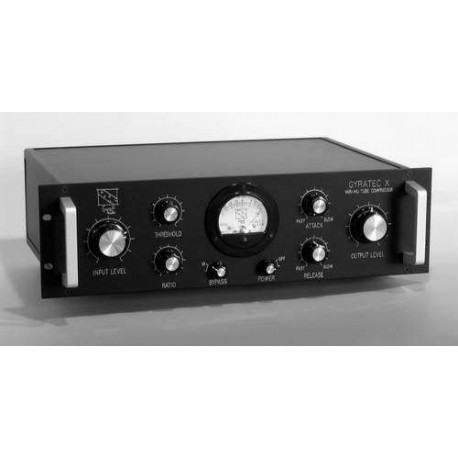No products
Prices are tax included
The G10 is a true tube stereo compressor based on the classic variable-mu principle. This method - controlling the gain by altering quesient current in differential tube pairs - is much faster than the optical method. The speed is why it was widely used in early limiter devices such as the Fairchild 670 or the Universal Audio 176, but the sonic byproducts of this topology are the main reasons why it is so popular today.
The controls on the G10 are as follows:
The input level pot is positioned right after the input transformers, thus allowing you to control the input level, the "drive" for the compressor.
The Threshold pot controls at what level the compression will set in. Turning counter-clockwize will select a lower start point, resulting in more compression. When turned fully clockwize, the compression is deactivated.
The Ratio pot controls the amount of compression in relation to changes in the input level, that is, for the part of the signal that exceeds the threshold value that is set. Setting Ratio fully counter-clockwize will deactivate compression.
The Attack pot controls the time the compressor takes to react to a rising input level.
The Release pot controls the amount of time it takes from the input signal falling below threshold, to the gain reduction being returned to unity.
The Output level pot controls the signal level to the output driver stage and the output.
The Bypass switch bypasses the unit completely. The hard way. - A relay simply takes out the active electronics and shorts the input to the output connectors.
We have recently further developed the G10 into the G10/Hpf version, which allows high-pass filtering of the controlling sidechain signal - allowing harder compression to bass-heavy material without pumping artefacts. The selection is done as 3 extra steps on the bypass switch, which gives cutoff frequencies of ca 80, 160 and 300Hz at a soft 6dB/oct.
The G10 is floating, transformer balanced in and out. Input impedance > 10K Ohm, output impedance < 1K Ohm.
It is based on a very minimalistic true-differential signal path from input to output, using very, very tightly selected PCC189 (7ES8) remote-cutoff dual triodes for the VCA stages, and E88CC (6DJ8) low-noise triodes as cathode followers for the output stage drivers. Both tubes are still fairly easily available throughout the world.
G10 is as standard available as a 230V mains unit - other mains voltages will be made on request (at no extra cost) - please specify when ordering



